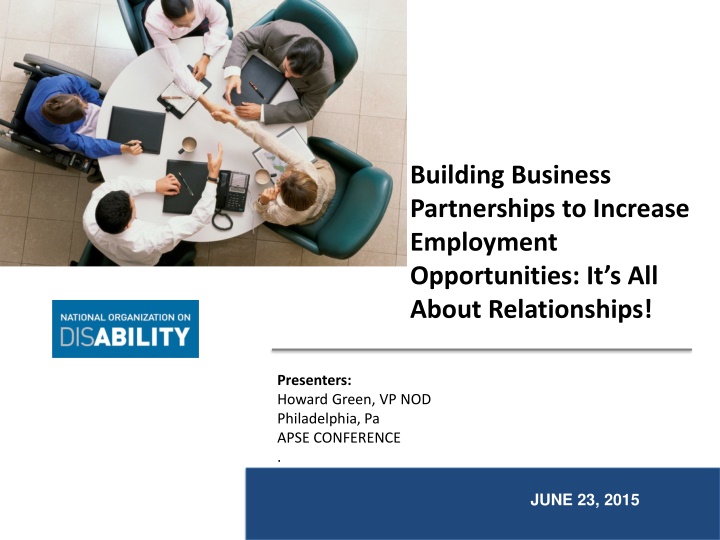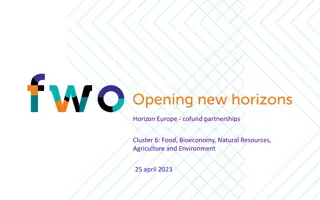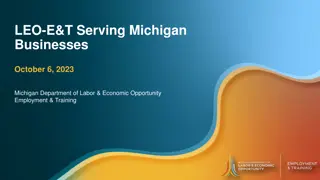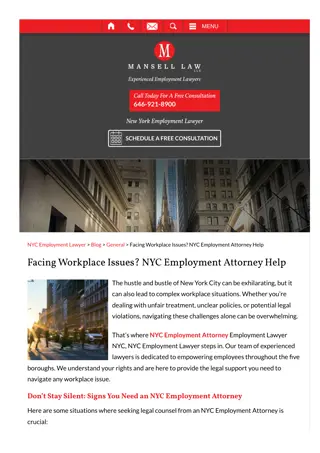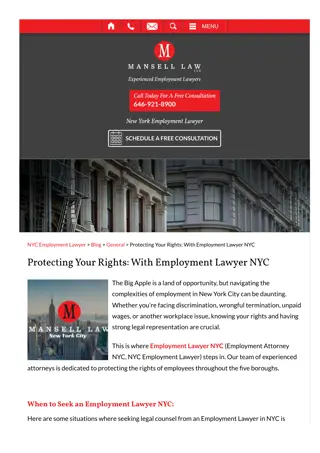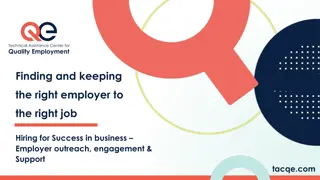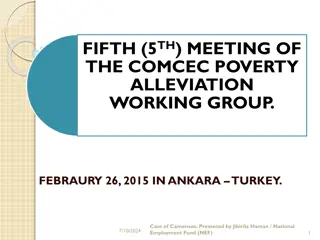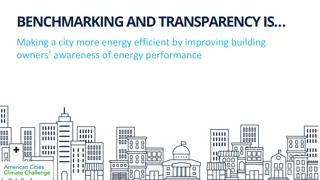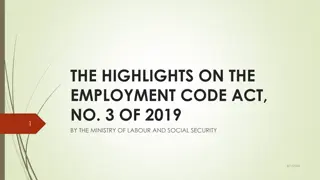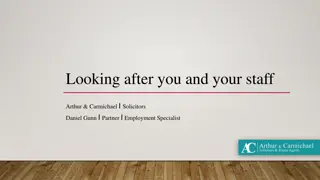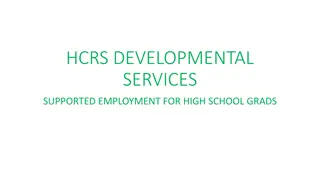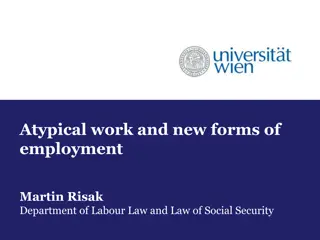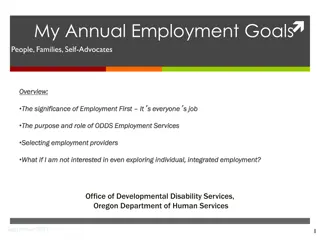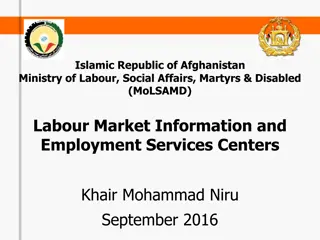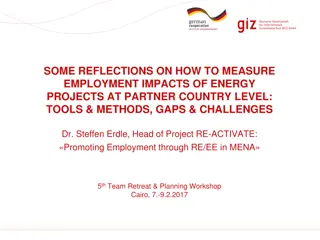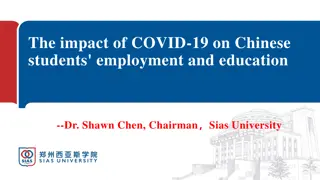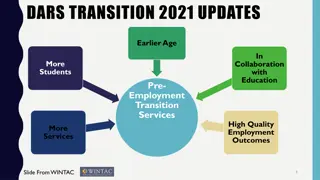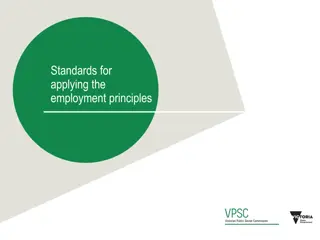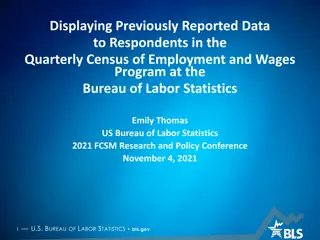Building Business Partnerships: Increasing Employment Opportunities Through Relationships
Initiatives by NOD focus on expanding employment opportunities for individuals with disabilities through relationship-building with businesses. The approach involves understanding business needs, offering tailored solutions, and maintaining strong partnerships. By shifting from traditional methods to a more personalized approach, organizations can create sustainable employment pipelines and deliver valuable services that meet the demands of the business sector. Building relationships, offering quality services, and fostering trust are key elements in forming successful partnerships for enhancing employment opportunities.
Download Presentation

Please find below an Image/Link to download the presentation.
The content on the website is provided AS IS for your information and personal use only. It may not be sold, licensed, or shared on other websites without obtaining consent from the author.If you encounter any issues during the download, it is possible that the publisher has removed the file from their server.
You are allowed to download the files provided on this website for personal or commercial use, subject to the condition that they are used lawfully. All files are the property of their respective owners.
The content on the website is provided AS IS for your information and personal use only. It may not be sold, licensed, or shared on other websites without obtaining consent from the author.
E N D
Presentation Transcript
Building Business Partnerships to Increase Employment Opportunities: It s All About Relationships! Presenters: Howard Green, VP NOD Philadelphia, Pa APSE CONFERENCE . JUNE 23, 2015
30-year-old nonprofit with a focus on employment for people with disabilities NOD has built an array of advisory services and networking opportunities for companies that are interested in taking a leadership role in the disability cause FOCUS Increase employment opportunity and economic self-sufficiency for working-age Americans with disabilities. CAROL GLAZER NOD PRESIDENT MISSION Expand the participation and contribution of the 57 million Americans with disabilities in all aspects of life. PRESIDENT GEORGE W. BUSH, STEVEN TINGUS & NOD FOUNDER ALAN REICH
Doing Business the Old Way! One person one job! (no pipeline) Community Rehabilitation Providers Don t track the right information Low expectations of candidates Not able or willing to manage the relationship
Business Needs & Concerns Policy, Procedures & Training Finding the right Partner for sourcing candidates Metrics Production, safety, cost of hiring Businesses Finding candidates ( the pipeline)
DOING BUSINESS A NEW WAY MARKETING YOUR ORGANIZATION! SEE THE BUSINESS AS A CUSTOMER Assign a person to manage the relationship! IDENTIFY THE BUSINESS NEEDS AND LEARN THEIR WAY OF DOING THINGS. TAKE TOURS AND OFFER ASSISTANCE TO HELP WITH THEIR DIVERSITY AND DISABILITY PLANNING. IMPLEMENT A STRATEGY TO MEET THE BUSINESS NEEDS. PRESENT THE BUSINESS A PROPOSAL OF WORKING TOGETHER. Build networks with other community rehabilitation programs to ensure you have the pipeline. BUILD AND MAINTAIN BUSINESS NETWORKS! Begin to track data for the business! PROVIDE QUALITY SERVICES AND IT IS ALL ABOUT RELATIONSHIPS, RELATIONSHIPS, RELATIONSHIPS, AND MORE RELATIONSHIPS! Move beyond the one placement idea.
Steps to Building a Relationship & Value DIALOGUE QUALITY OF SERVICES FRIENDSHIP & TRUST RELATIONSHIP ADDED VALUE TO THE BUSINESS Providers need to start networking & talking with businesses. First step in building relationships is meeting the right people and making sure you know their needs and issues. Once you have met & decided to try to meet the business needs you need to provide top quality services. If you don t deliver a quality service, the business will go to another vendor. If you are providing quality services & the business can depend on you being responsive, dependable and trustworthy then you create a friendship and trust. The business needs to trust you before they hire your company or people. Once you can show you can deliver and can be trusted then you have a relationship and will be seen as a partner. If you are willing to go the extra mile, deliver quality services and meet the needs then you will continue as a partner and have a great relationship. Quality services, being responsive to the demands of the business, building trust and contributing to the bottom line are adding value to the business.
Why is the Bridges to Business Model needed? Company Quotes/Employer Feedback Employer #1 I wanted to hire workers with disabilities and agreed to work with a local agency but it took too long for them to find any candidates. Employer #2 I wish I had a real community partner who understood my needs and wanted to meet my objectives --- not theirs! Employer #3 It seems my company has to go looking for the partners in the community, and it is confusing. It would be nice to work with one organization that would manage this for us. Employer #4 I expect more people with disabilities could secure employment if more programs worked together. Employer #5 We worked with an agency but they couldn t deliver the talent and when we expressed frustration, they said they couldn t really help us and then we never heard from them again. Employer #6 Help, where do I start? I need help navigating the system.
Why is the Bridges to Business Model needed? Company Quotes/Employer Feedback Employer #7 I thought the biggest issue would be that the candidates would not be productive but the biggest problem was finding a PARTNER to help me . Employer #8 I triedto find a partner but it took me forever and I almost gave up . Employer #9 How do I know if a provideror rehabilitation agency is a good provider ? Employer #10 Whydon t the local providers work together to help businesses and candidates with disabilities? Employer #11 Is it okay to fire a job coach? Employer #12 I thought it would be easy to do this but I learn that most organizations are only worried about their needs and not mine .
Know what you needKnow what to ask Supply (Service Provider) Side: Do they have a strategic plan for addressing business needs? Demand (Employer) Side: Do you have a diversity plan & does it include disability? Do you have a disability program & is someone assigned to manage it? Do you set targets to hire candidates with disabilities? Do you have an accommodation policy & is it centralized? Do you offer training on disability to their employees? Do you have a community partner(s) to help with sourcing positions? Is the partnership working & reaping benefits Do you track things like production, retention, cost per hire, safety etc.? Do they have a data base to track their business relations? Do they track their success and offer to track information for the business? Do they offer disability training? Do they assign a business manager to the business? Do they have resources & networks beyond their organization. Do they have a pipeline of candidates to meet the appropriate needs of a specific business?
Single Point of Contact vs. a Valued Partner What it looks like VALUED PARTNER SINGLE POINT OF CONTACT Driven by the Business and their Driven by rehabilitation agency or needs. an Employment Services Provider. Mutual understanding of roles and One-sided expectations from expectations. Supply side. Willing to work with other Willing to source candidates from rehabilitation programs in the their caseloads only. community to find the talent for Services to businesses are businesses provided on a short term basis and Services to businesses are seen as driven by funding for a particular on-going and built on a business person with a disability. relationship.
Outcome Nuggets From the Bridges to Business Model Businesses want to work with a preferred vendor Businesses need a partner to help manage the business/disab ility relationship Businesses do not know how to find the pipeline of candidates with disabilities THERE IS A DIFFERENCE IN A SINGLE POINT OF CONTACT AND A PARTNER FOR THE BUSINESS. BUSINESSES NEEDS A PARTNER TO TRACK THE DATA AND PROGRESS.
Example of Bridges Work -Timelines for Engagement NOD interviews organizations for potential partners and recommends :several for 2nd interviews by companies such as :Lowes, JB Hunt, Kroger, Sodexo, PECO, Toys R Us April & May June & July September & October November & December Interviewed for Lead Partner with companies attended Disability Awareness training; tour company, . Developed on-boarding process for partnership; job coaches selected and trained at Companies; scheduled interviews & onboarding candidates. Continued to fill positions and expanded opportunities into other areas of business Started expanding to different departments & screening additional candidates. Candidates started working and learning job with assistance from job coaches; feedback on productivity & assessment of program continued. Additional departments were added. Candidates hired and continued on-going communication between Provider and Companies represenatives. NOD, Provider and company met to review Roles and Responsibilities; reviews companies needs. CO learned requirements & started selecting potential candidates. Provider & Companies started meeting regularly to build trust and communication process; NOD scheduled bi- weekly calls to review progress.
Partnership Roles Business Based on input from NOD, Provider was selected as Lead Partner Staff participated in Disability Awareness Training Companies identified labor needs for Distribution Centers and other sites Provided tour and training for Provider staff and job coaches Provided on-going and continuing communication with Provider staff
Partnership Roles Provider. Participated in Disability Awareness Training at Companies Screened candidates for positions at Companies Marketed the programs to other community providers ( VR, Veterans(DVOP) DDS) Selected candidates for interview and prepared Companies Job coaches provided necessary training and on-going accommodation advice to Companies Tracked progress data and shared with Companies staff and management Participated in bi-weekly calls with Companies and NOD
Nuggets Learned from Partnership Assignment of a Project Manager to business partner is critical Providers learned the needs of business (importance of background checks) Flexibility of business as well as provider to ensure success in matching candidates to positions Co-worker s productivity increases Continuous building of pipeline
PROMISING BUSINESS PRACTICE Walgreens Distribution and retail stores Lowes 14 Distribution Centers Modeled after Walgreens Giant Eagle creating an internal focus to work with community rehabilitation agency and providers Sodexo- leader in Diversity and in the top ten in hiring people with disabilities, Safeway uses an internal champion to increase hiring. Wal-Mart/Sam s- Working to increase their hiring and developing a consortium in NW Arkansas with their vendors. AMC Theatres Working to improve their ability to recruit and hire as well as working job coaching guidelines. Over 1000 new hires in 350 + theatres. CVS moving to hire more in their Distribution Centers. Best Buy Using the Walgreens model in their distribution centers- some of their stores have a program for individuals who are deaf. Kroger- working to expand their retail and start hiring in their Distribution Centers Office Max- Creating jobs in Distribution Centers NV, IL, MD & AL Toys R Us expanding their hiring in their distribution centers.
When your boss asked what did you learn? Tell them this Here is what you can tell him/her: Tracking is IMPORTANT! Create a data base of business relations (not just counting placements. Best Practices Abound Provider organizations are more effective all across the US when they partner with each other. Contact NOD about employers in your industry who are actively involved in disability employment. Know where you Are: An internal audit is key to understanding opportunities for development or expansion of business development. OFCCP is here: Impacting federal contractors initially -- Companies outside the federal contractor space are also staring initiatives. Get Started/ Align with your business Ensure your business development programs align with business/organization s objectives. Don t create your business development that is nice to do create one that is a need to do . It is all about the message and relationships. Consider changing from being know as a placement counselor to a talent connector . 17
NODs top 10 list for companies with steps to create or evolve their programs 1. Understand people with disabilities can be a viable part of your workforce (if you don t believe it now, get training, see it in action) 2. Know what you want your program to be, what will it look like, what will make it unique to your company? 3. Conduct an audit of existing disability initiatives: Where are you? Where should you be? 4. Identify opportunities to bring candidates with disabilities into your workforce (e.g. peak, off peak, internships, part time, utility or casual employees) 5. Identify local partners who will help supply talent with disabilities 18
NODs top 10 list will provide companies with steps to create or evolve their programs..cont. 6. Set Goals hire people with disabilities along with all other sources of talent (when will you have your first new hire class?) 7. Train your staff define the program, expanding diversity, better community partners and help them see that people with disabilities can and will contribute 8. Establish Internal Champions/Stakeholders on the ground supporters who will help answer questions and bring information to leaders about resistance 9. Don t be afraid to make mistakes get feedback, don t be afraid to try new things 10. Track, Measure & Share Progress document the successes, and what didn t work so well. Keep trying. And share your results with others 19
Resources Contact: Howard Green, NOD, greenh@nod.org / www.nod.org Websites: DOL FAQs regarding regulations for individuals with disabilities: http://www.dol.gov/ofccp/regs/compliance/faqs/503_faq.htm DOL FAQs regarding regulations for protected veterans: http://www.dol.gov/ofccp/regs/compliance/faqs/VEVRAA_faq.htm Kessler Foundation/NOD Survey of Employment of Americans with Disabilities http://nod.org/assets/downloads/01-2011_Exec_Summary.pdf Employment Resources: http://nod.org/disability_resources/employment_resources/ For more information on the Disability Employment Tracker, visitwww.nod.org/tracker To register to take the Disability Employment Tracker, email tracker@nod.org
